How pop culture and climate anxiety have galvanized a new generation of clay artists
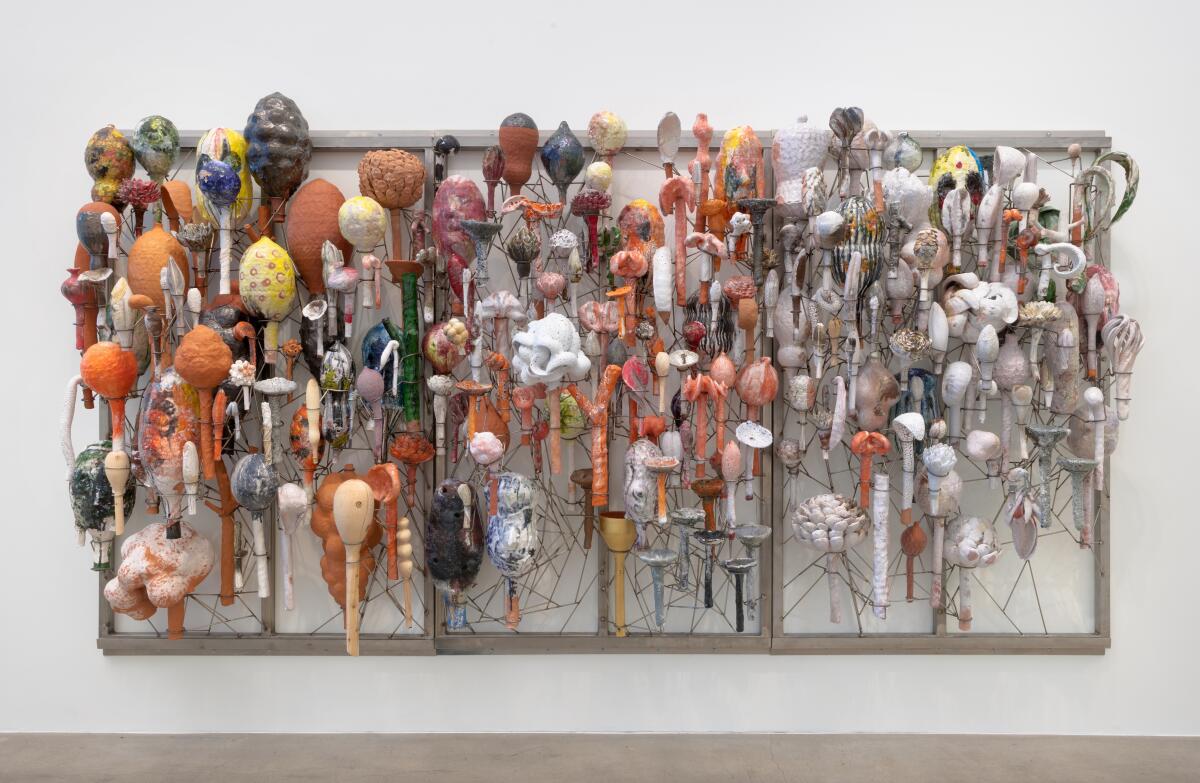
- Share via
There’s no shortage of clay art shows to see right now around the country. At the Museum of Arts and Design in New York, “Funk You Too! Humor and Irreverence in Ceramic Sculpture” highlights 50 bold pieces created from the 1960s to present day. LGBTQ+ artists are the focus of “Making in Between: Queer Clay” on view at Pomona’s American Museum of Ceramic Art. And the Metropolitan Museum of Art just debuted “Grounded in Clay: The Spirit of Pueblo Pottery,” curated by the Pueblo Pottery Collective and billed as “the first community-curated Native American exhibition in the history of the Met.”
Two recently opened shows near Mid-City Los Angeles especially capture the range of contemporary clay artists’ ideas. “Wayfinding,” Craft Contemporary’s third clay biennial, features the work of 14 contemporary artists “who harness clay’s powerful physical and metaphorical properties to embody their ties to land and water,” as described on the exhibition’s website. A short drive away, “Clay Pop Los Angeles,” curated by Alia Dahl at Jeffrey Deitch, embraces a playful and bold approach to clay, focusing on pop culture influences.
These two group shows highlight the themes contemporary clay artists are exploring — namely modern anxieties around industrialization and climate change as well as ancestral memory. As contemporary artists continue to push the possibilities of ceramic art, they are utilizing the medium’s connection to nature, time and chemistry to explore both global and personal narratives.
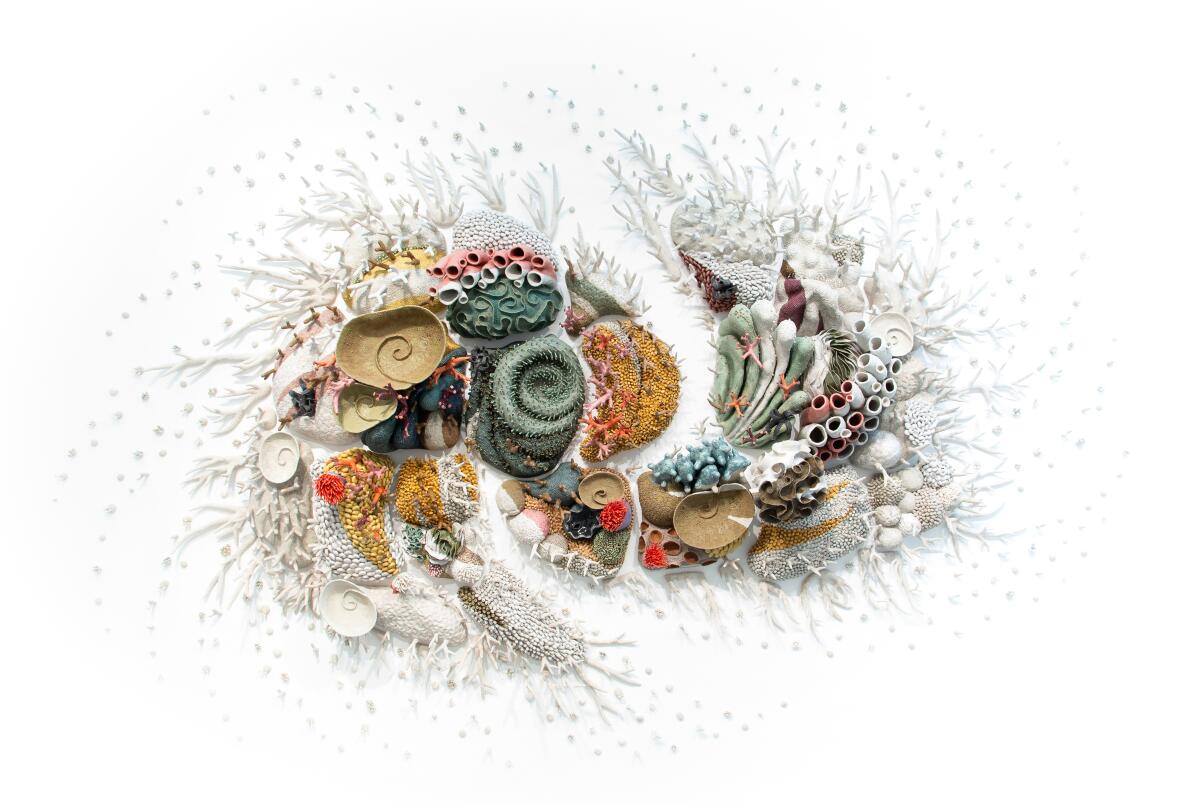
One artist who works with clay, the San-Francisco based Courtney Mattison, creates work that highlights climate change, drawing from her background in marine ecology and environmental studies. “Our Changing Seas IV,” created from 2016-19, sprawls over a large wall in “Wayfinding,” immersing the viewer. Mattison often uses everyday objects, or tools she makes herself, to painstakingly re-create the texture of coral reefs.
“I want people to see what I see when scuba diving on a coral reef — to feel like they’re hovering above it and discovering details from every angle,” Mattison said.
This form of close looking requires we also acknowledge the bleaching of coral reefs, a result of rising water temperatures. Mattison’s installation shifts from colorful and vibrant hues to stark, white sections, calling attention to the fact that these ecosystems are still alive — it’s their skeletons that we are seeing.
“It is essential that the medium of my work be ceramic, as calcium carbonate happens to be both a glaze ingredient and the compound precipitated by corals to sculpt their stony structures,” Mattison said. “Not only does the chemical makeup of my work parallel that of a natural reef, but porcelain tentacles and the bodies of living corals share a sense of fragility that compels observers to look but not touch.”
Drawing on decades of ceramic work, Joan Takayama-Ogawa also brings issues of climate change into her art, with a number pieces on view in “Wayfinding.” These range from 30-inch to 40-inch all-white sculptures that nod to the Great Barrier Reef to 4-inch ceramic cupcakes with syringe pens in them, their “frosting” devoid of color.
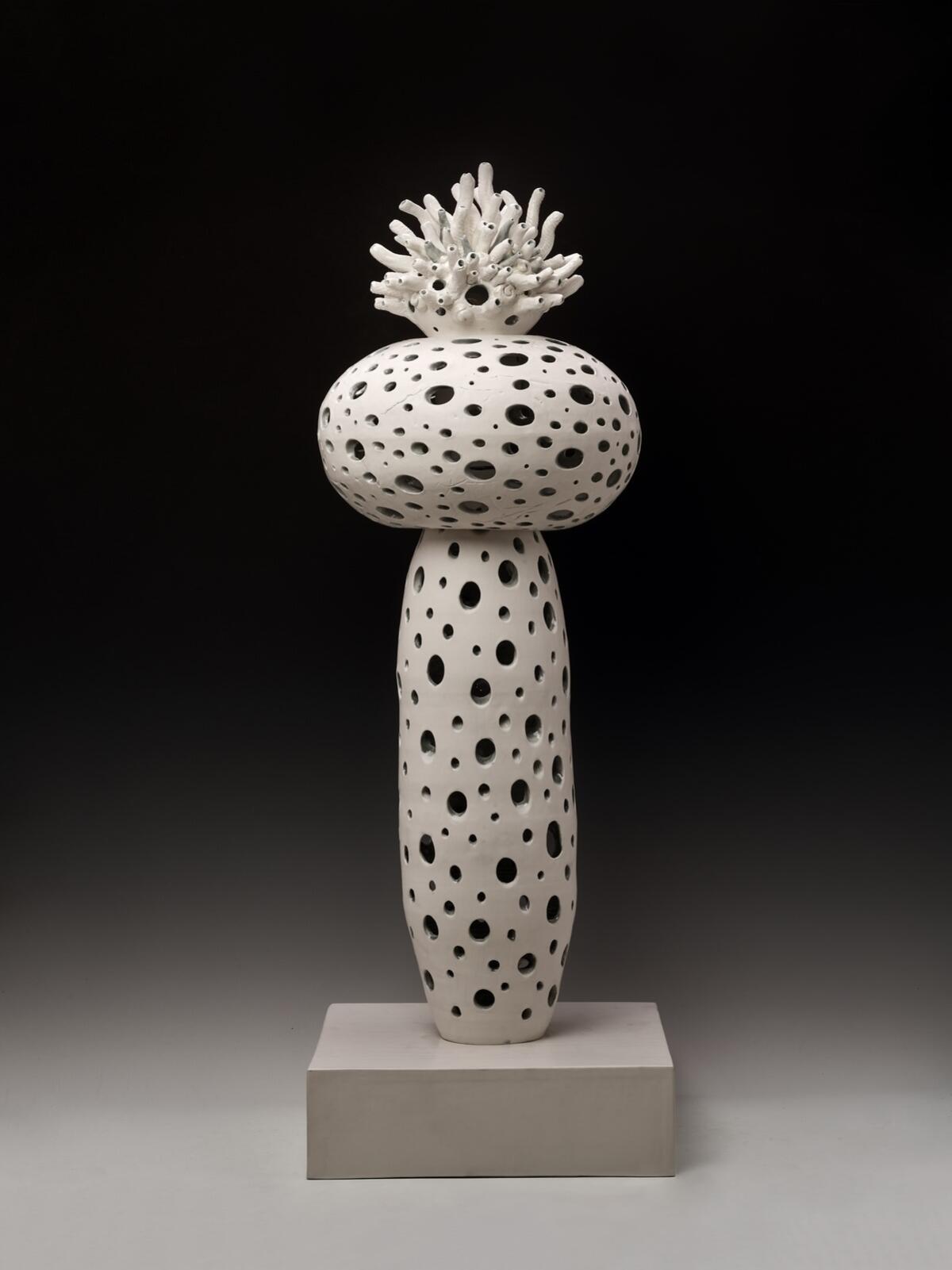
The artist and educator’s ceramic pieces hold “scary messages” while leaning into beauty, she explains. Takayama-Ogawa recalls how a student at Otis brought her “white coral chunks” from Guam, the student’s homeland. That was in 2009; by 2015, the artist made coral reef bleaching a major part of her practice. She recently embraced a new direction: holding off on colorful glazes.
“A lot of people are surprised that I’m working in white right now,” Takayama-Ogawa said. “But that’s because of the intention and the concept — and the story of bleached coral.”
The changing landscape and humans’ effects on the land play a part in many of the works on view. Pueblo of Isleta and Navajo artist Rowan Harrison says that his Southwestern roots include “a strong traditional lineage when it comes to working in clay.” The Fullerton-based ceramicist has several works on display in “Wayfinding,” all of which are built and painted by hand. Two untitled works are especially striking in the way they showcase Harrison’s approach to mixed media. A vessel made of Native clay, which Harrison will sometimes dig himself, is punctuated with rusted nails. The forms hold opposing worlds: the earth energy of clay juxtaposed with the mass-produced nail.
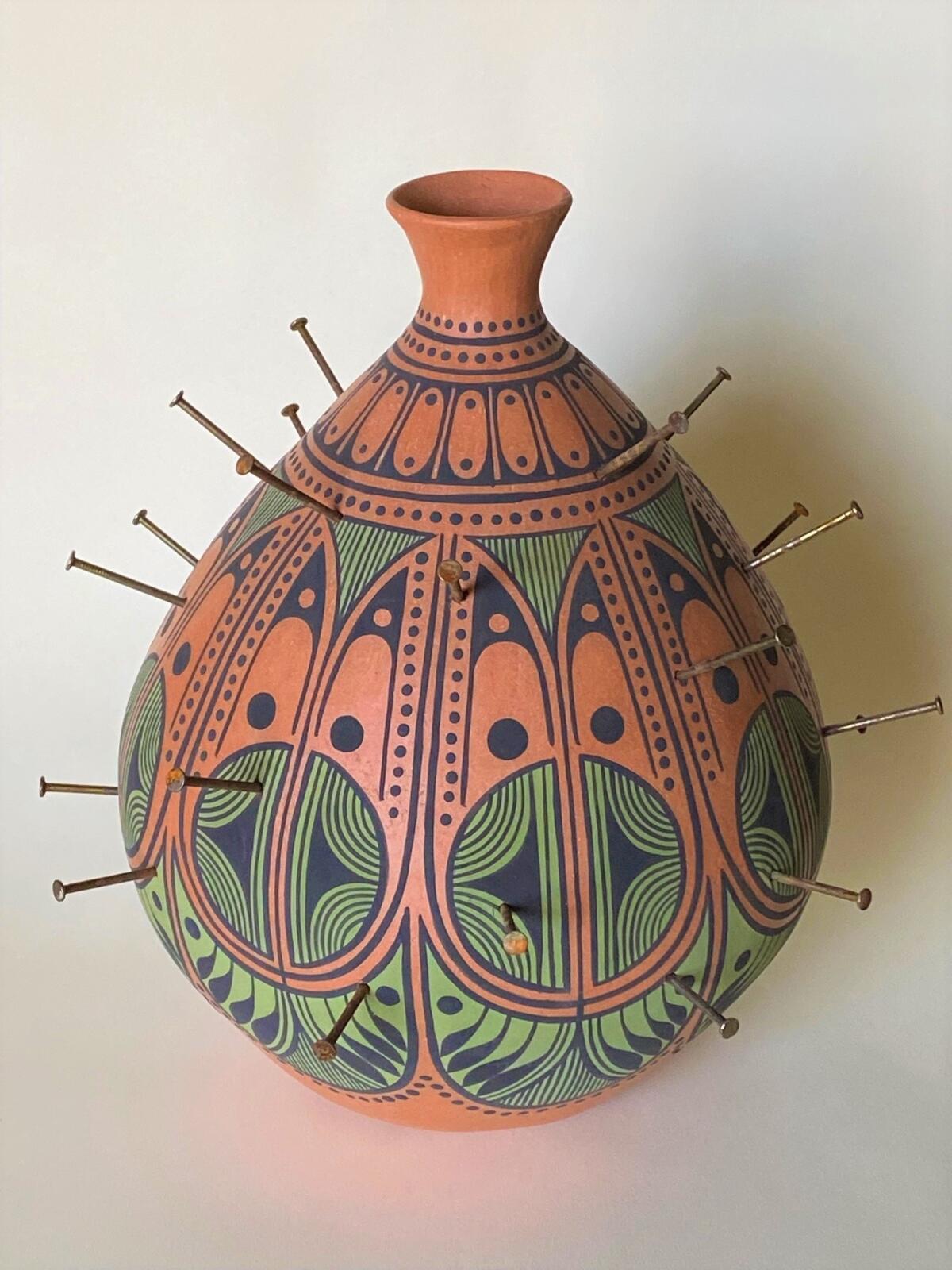
“There have been situations where we have lost family, friends, tribal members because of this idea of industrialization moving into, or encroaching into, Native land,” said Harrison. “The metal pieces represent that kind of technology.… I’m trying to represent this harmony or this balance, if you will.”
The artist cites Robert Rauschenberg, George Herms and Bruce Conner as inspirations for his interest in assemblage. Harrison often combines “traditional Southwestern Pueblo motifs” with more contemporary designs; he often picks up brackets, doorbell covers and machinery pieces, bringing them to the studio to see where he can incorporate them.
“I consider myself one of these Native American artists who has one foot in the traditional world and also one foot in the contemporary world — that is predicated on the materials that I use and the design elements as well,” Harrison said.
Lizette Hernández, whose work is featured in both “Wayfinding” and “Clay Pop Los Angeles,” also thinks a lot about the ties between tradition and our present moment. The Los-Angeles based artist created a series of raku-fired works for Craft Contemporary; at Jeffrey Deitch, you can see three glaze and glass on stoneware pieces, also completed this year.
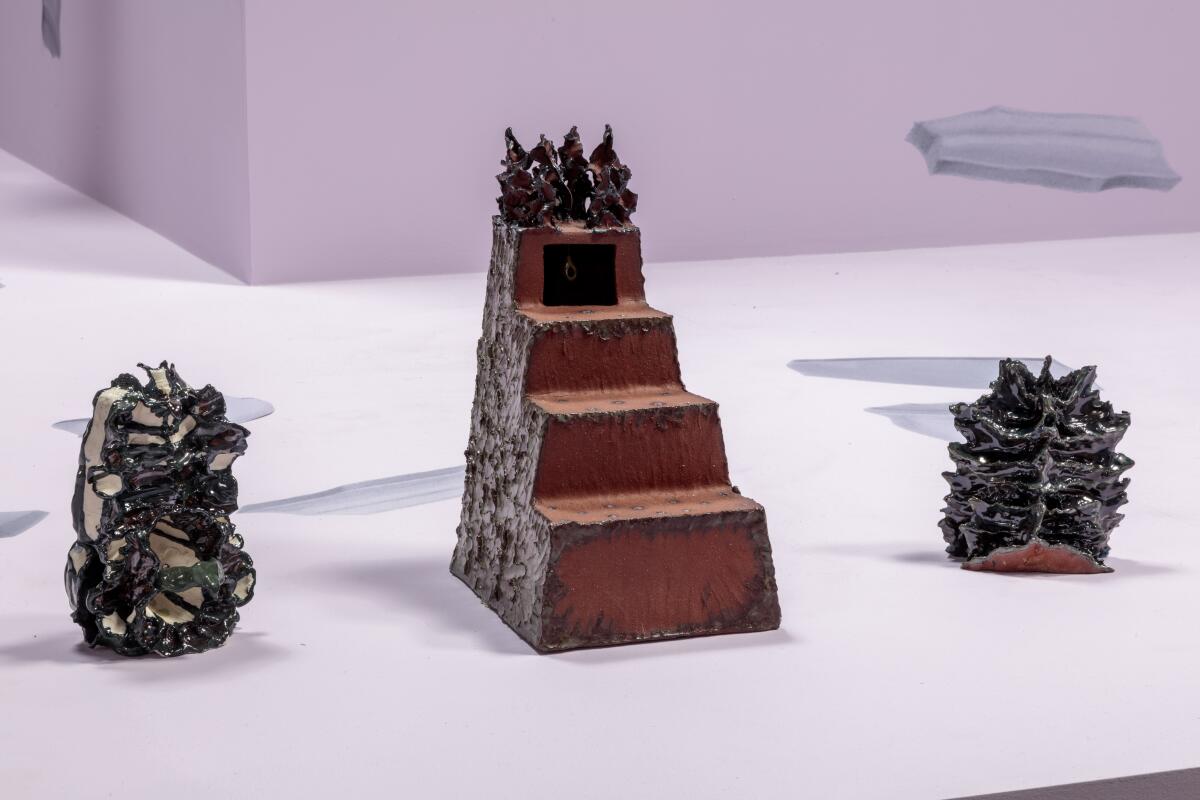
Growing up in a religious home, Hernández was familiar with Christian iconographies and sacred items. Titles like “Cielo, Tierra, Guía, Guardia” (the name of her pieces at Jeffrey Deitch, which roughly translates to “Sky, Earth, Guide, Guard”) bring to mind stories of ancestral guides and celestial beings. But she sees clay as “a spiritual material outside of any religiosity.” Her work takes inspiration from altar pieces and shrines to explore a wider definition of sacred objects.
In her visually complex raku-fired pieces at Craft Contemporary, she embraces the oxidizing of glazes and leaves imprints of her hands in the clay, emphasizing the collaboration between herself and the material. Hernández carefully considers how water affects clay, even after it evaporates — “the material holds its shape, so it holds memory,” Hernández said.
Across both shows, there’s a palpable respect and excitement for the possibilities of clay within our contemporary moment. Compared with other mediums, clay has a certain alchemy, chemistry and transformation tied to its mystique.
“There are so many things that can go wrong, but there’s also such a great sense of satisfaction when you get the results you want,” Mattison said. “Sometimes you can open the kiln and get something even better than you expected.”
For all their fragility, ceramics also hold an innate power: you never know what can happen in the process, but that’s where the magic lies.
“The kiln is the great equalizer and keeps most of us pretty humble,” Takayam-Ogawa said. Hernández echoes this sentiment, describing her relationship to the process as a “surrender.”
“I try to embrace the clay and allow it to kind of have its own life, because it does. It goes through experiences that I can’t experience,” Hernández said. “It goes through extreme heat and interacts with different chemicals … all I have control over is my hands connecting with it.”
‘Clay Pop Los Angeles’
Where: Jeffrey Deitch, 7000 Santa Monica Blvd., Los Angeles
When: 11 a.m.-6 p.m. Tuesday through Saturday. Closes Aug. 12.
Info: (323) 925-3000, deitch.com/los-angeles
‘Wayfinding’
Where: Craft Contemporary, 5814 Wilshire Blvd., Los Angeles
When: 11 a.m.-5 p.m. Tuesday through Sunday. Closes Sept. 10.
Info: (323) 937-4230, craftcontemporary.org
More to Read
The biggest entertainment stories
Get our big stories about Hollywood, film, television, music, arts, culture and more right in your inbox as soon as they publish.
You may occasionally receive promotional content from the Los Angeles Times.










